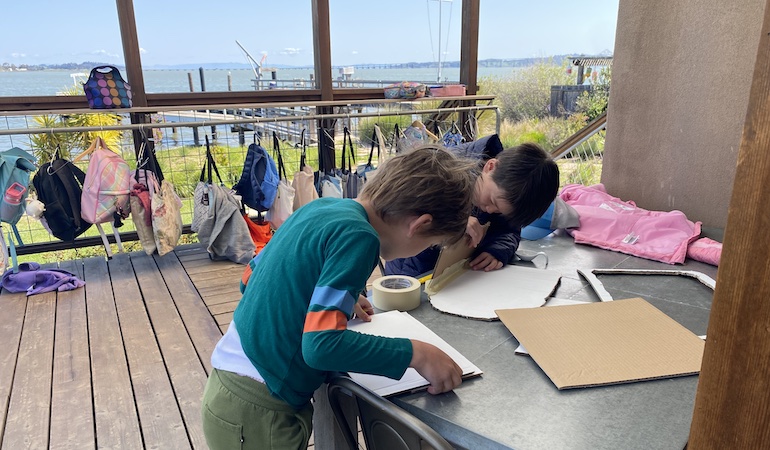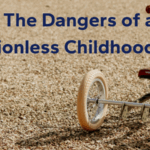My three children are as distinct and beautifully themselves as any three human beings can be – and yet they undoubtedly developed along a nearly identical track, experiencing the same lurches and regressions at roughly the same stages of development.
As much as they are individuals, they are profoundly predictable.
And they’re not alone. We’re all this way. A hundred years ago, Dr. Maria Montessori and her son, Mario, noticed this paradox in the children whom she observed. Each child is both an individual and a human being imbued with Human Tendencies that are as immutable as they are powerful.
The Human Tendencies are a set of characteristics that are apparent and observable in all children during the course of their development. They unfold regardless of context or era.
Something powerful happens when you raise and educate children in accordance with their tendencies instead of in opposition to them. Building environments and experiences around the tendencies allows children to flourish as independent, curious, generative, and engaged citizens. Moreover, these kinds of environments actually assist children with their development
The opposite is also true.
And so it makes sense to build environments and adust them so they make use of the Human Tendencies to guide children to learn in deep and enduring ways. When we do so, our children blossom.
It’s magical but not magic.
Dr. Montessori identified a very lengthy list of tendencies. For parents and educators with elementary-aged children, here are a handful of the most important ones and how we can take advantage of the tendencies for growth.
Human Tendencies
Order
Children naturally seek order and recoil at chaos. Consistency elicits feelings of security and confidence. They want to know what’s going to happen next and they want expectations to come true.
As adults, we can use this natural tendency to inspire creativity and calm anxiety. A few tips:
- Set up materials beautifully and in the same place
- Offer a consistent daily schedule
Orientation
As part of their tendency to gravitate toward order, children also naturally seek to know where they are in time and space. Parents can mistake this tendency for impatience when children ask, “Are we almost there?” “When is dinner?” “What are we going to do tomorrow?”
Instead of exasperation, offer orientation:
- Explain succinctly and clearly what they can expect from an experience.
- When something is going to happen that is out of the norm, let your children know ahead of time what they can expect, even if it is just that dinner is going to be late or that you are going out for the meal.
- If you are staying at a hotel or at a relative’s house, walk through the space so that your children can get a lay of the land. Let them know what is and isn’t okay to do in this new environment.
- As children get older, these conversations might grow to include what they might expect at a social event. If they are nervous about an encounter, you can talk through how they might respond to different scenarios. For instance, we have a rule in my family that there are no devices at the dinner table whether we are at home or at a restaurant. However, not all families have this same rule. So, when we went out to dinner with others when my kids were young, I always oriented them to the fact that other children (or adults) might have devices at the table. The rule for them would not change, and we could talk through anything they think might come up.
Exploration
Exploration is the means by which we satisfy our curiosities. If this tendency can be utilized in education, children can truly achieve their potential. This is the means by which we develop movement, intelligence, and the senses. Exploration is the key to knowledge! This is an important opportunity to observe and prepare your home environment for your child.
Observe to learn what your child is interested in exploring (volcanoes, baking, insects, etc.) Then, set up a space in your home where their exploration is supported.
- If they are interested in baking, set up the kitchen so that your child has access to the tools they will need, including cookbooks they are able to use successfully on their own.
- A few tips for baking or cooking:
- Think through the rules you want to establish about using knives and fire. (I encourage you to allow them to do healthy-risky things as soon as they demonstrate that they can attempt them responsibly.)
- Orient your child to the kitchen and where things are.
- Invite them to cook with you until you see that they have the capacity to do some things independently. (This will happen quickly as they are doing practical life activities at school that include food prep as well.) Once they have mastered some things they can do independently, introduce them to jobs with increasing challenge. (e.g. once they can slice the banana, introduce pickle slicing or once they can spread cream cheese on toast, introduce them to assembling a sandwich)
- Have a good selection of children’s cookbooks available or go to the library to check our cookbooks with your child. I like all of Mollie Katzen’s children’s cookbooks, and so do my children!
- A few tips for baking or cooking:
- A few tips for supporting research:
- Especially for Elementary children, interest in research offers an opportunity to get out into the community where they can learn how to move through the social world. So, when your children bring up areas of interest that could be researched, go to the library! We had a Friday library habit in my family when my children were young. After school on Friday, we would go to the Aina Haina library. There was a lovely coffee shop next door. So, we could get a treat and books! Still today, the library is a happy place for all of us.
- In addition to the library, following your children’s interests offers opportunities for weekend adventures. If your child is interested in elephant seals, you can go to Año Nuevo or Point Reyes to observe them. If your child is interested in botany, you can go on a hike or visit a botanical garden. The San Francisco Botanical Garden in Golden Gate Park has a prehistoric garden, a California native garden, and a smelling garden, in addition to many other attractive sections.
- If your child does not regularly tell you about their interests, you can do all of the above based on an interest of your own. If you talk to your child about something you are passionate about and go on adventures based on your curiosities, they are more likely to start sharing their own ideas and interests with you.
Movement
Movement is the tendency that is perhaps most often impeded by adults. If we recognize that movement is an essential component of education, we are able to establish learning environments that allow children to work with their natural urges rather than against them.
This is something to consider at home as well. When children are running wildly through the living room, we must remember that we want them to learn how to walk calmly where it is appropriate to walk and run. This gives children the opportunity to practice and perfect their movements.
Time-outs, on the other hand, simply take movement away. When in time-out, the children do not have an opportunity to practice graceful movement. Movement is taken away.
Communication
Communication is the means by which intelligence is developed and expressed. There is an incredible drive to acquire communication for toddler and primary-age children. We must always be aware of ourselves as models of gracious and appropriate communication. Modeling is the primary means by which young children acquire language and communication skills.
Post-Covid, we see that children who have had less exposure to people speaking to them or people speaking with their mouths visible might be delayed in their own language development. We also see some children who are less attuned to being spoken to. This may be related to being in environments where there was a lot of adult speaking that was not directed toward children, or people speaking to them without using the tool of eye contact to indicate a connection.
Notes on communication:
- As role models of communication and interaction with other humans, know that your Elementary children are keenly observing your words, your tone, and your body language.
- Model focusing on your child when you are in communication with them. Look them in the eye, pause the other things you are doing, listen to them with intention, and speak mindfully.
- If you are not available to talk when your child approaches, tell them that. Say something like, “I’m not available to give you my attention right now. And, I really want to be able to listen carefully to you.” Then, let them know when you will be available to connect.
Manipulation
Manipulation refers to the use of the hands to explore objects. This is the way that we directly experience our environments. By holding a sphere, we feel its texture, we experience its weight, we know whether it will bounce or not, we know whether it is warm or cold, and we can see how its size compares to that of our friends’ heads. Using screens is not manipulation.
Work
Work involves manipulation and activity. What it adds to the mix is the presence of a specific goal or purpose. Thus, work can be defined here as purposeful activity. One of Dr. Montessori’s greatest discoveries was the observation that work, above all else, brings to the child a sense of well-being.
Strategies for getting your child to work at home:
- Ensure that your child has regular chores that contribute to life at home. It is important for them to take care of their own spaces and their own things. And, it is important for them to have opportunities to do jobs that benefit the family.
- Examples of daily chores include setting and clearing the dinner table, doing dishes, and making meals for the family.
- Examples of weekly chores include cleaning bathrooms, laundry, organizing the coat closet, sweeping/vacuuming, weeding the yard, dusting shelves, cleaning the kitchen, dining room, living room, etc.
Repetition
Children do indeed have a natural urge to repeat their activities. They have an inherent interest in working until they understand. Repetition satisfies this urge. Remember the value of repetition when you hear your child telling you that they have done the same work every day for the last month!
A note about screen time and repetition:
- Repetition is a Human Tendency that is at risk. It is linked to the dopamine system that rewards us for working hard to achieve a goal. In the case of repetition, we are motivated to repeat and repeat and repeat an activity until we achieve understanding of the subject matter or mastery of the skill. When we achieve these, our brains give us a little hit of dopamine, which encourages us to work hard again sometime. However, time on screens offers dopamine hits without the effort of hard work. Thus, screen time hijacks our bodies’ natural motivation system. The greatest gift you can give to your children is to limit the time they spend on screens.
Exactness, Control of Error
If repetition is the child’s practice, exactness is their goal. This is the aim that we want all of our children to achieve. This is the ‘right answer’ in math. The way that we encourage children to nurture their inner urges toward exactness is with practical life activities.
Because practical life activities have such natural consequences for any errors made, they fortify the child’s own instincts toward exactness. Children carefully carry pitchers of water across the room because they know that if they spill, they have to clean up.
This is one of the reasons that it is so important that we not step in to clean up messes for our children at home. The more they have to clean up for themselves, the stronger their drive toward exactness becomes.
So, the more you expect of your children in terms of their responsibilities at home, the better they will be at math!
The Montessori materials also have built-in controls for error that encourage this instinct toward exactness.
Abstraction
Abstraction is the ability to think about an object or an idea in its absence. Abstraction can not truly be achieved without concrete experience. The beauty of the Montessori curriculum from Toddler to Teen is that it progresses from very concrete, material-based experiences through layers of increasing abstraction until the students get to mastery.
They no longer need the physical materials because their brains have built a storehouse of images that support their abstract thinking.
Self-Perfection, Self-Control
All of the Human Tendencies together help the individual to work toward self-perfection. This is a term Montessori used to describe the best version of one’s self.
It is not our goal to develop perfectionists who are uncomfortable with error, but rather fully realized humans who practice being their best selves regularly.
In order for children to achieve this, we must remember not to distract them from the objectives they set for themselves. This is why it is important that we know the Human tendencies and protect them in our children.
If we can do this, the children themselves will develop their potentials because they are internally motivated to do so.
We think of these (and many other!) Human Tendencies when we are preparing our environments, when we are observing each child to determine what is helpful for them and what is detrimental, and when we are planning the lessons that we offer to help your children develop to their potentials.
When parents can do the same at home, they often find that their children are happier, more focused, and more enthusiastic about the world around them.

As the Director of Education for Elementary and career-long Montessori educator, Minnie relishes the gift that a Montessori education offers to children, families, and society.





